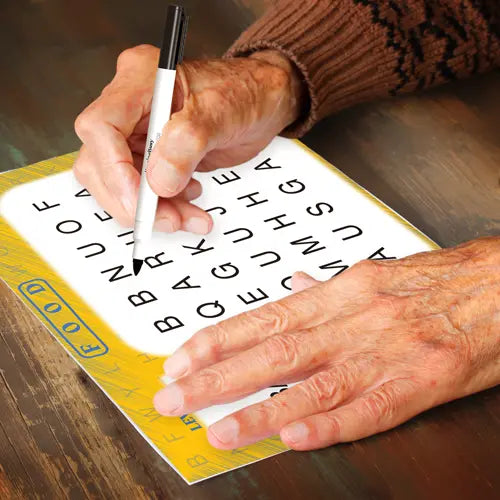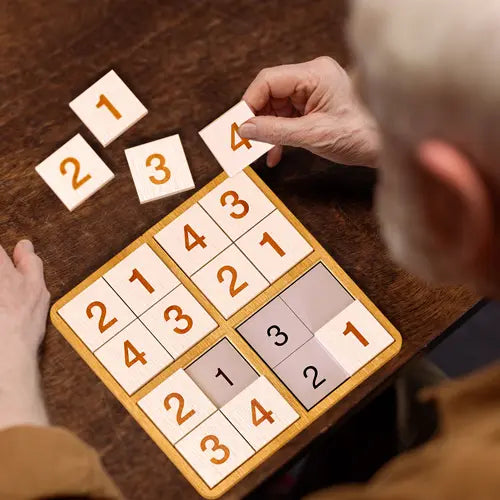
You have selected an activity, made sure that it is suitable for the person and that it meets the requirements of a proper Montessori dementia activity. What next?
Of most importance is your mindset. You have to be ready to coach the person, observe how they handle the tasks involved, give them the time they need to complete the tasks, and celebrate their successes with them. If everything comes together, if your hard work pays off, you will be rewarded beyond your expectations with the moment of accomplishment that you will share with together.
Next is to prepare the space that you will use to do the activity. The area must be free of distractions:
- Is the area free of physical clutter?
- Are there background noises?
- Are there distractions visible through the window, through doorways or elsewhere?
- Are people talking in the other room?
All of this can make it more difficult for the person with demen tia to concentrate and become engaged in the activity.
Make sure that there is sufficient lighting and a comfortable chair. Make sure that the table is at a good height, is big enough for what you are doing and has a proper surface. A work mat coloured to contrast with the materials that are used in the activity is ideal.
PREPARATIONS
- Is area free of distractions?
- Is there proper lighting?
- Is there comfortable seating?
- Is the work surface at a good height and large enough?
- Do you have all the materials at hand?
- Do you have a backup activity prepared?
Before inviting the person to join you, make sure that you are ready. Have all of the materials at hand, organized and ready to go. Have a backup dementia care activity ready to go in case the first activity doesn't appeal to them this time. The backup activity can be something as simple as sorting socks, folding tea towels, putting the cutlery away, just something that you can turn to instead of walking away and missing the opportunity. Maybe they'll be ready to do the planned activity after doing the backup.
Once everything is in place, invite the person to come help you or come see something. Use as few words as possible, keep it simple and ask a question. "Would you like to help me?", "I have something to show you, would you like to see it?", "Do you want to follow me?". Try to phrase the question in a way that makes it unlikely that they will say no. You know the person best so use phrasing that you think will work.
If the person says no, you can try saying something like "Ok, I'm going to go anyways, you can join me later if you like" or "Ok, it's your choice but I think you would like it". The idea is to encourage them to join you by making it sound appealing, but the choice is theirs. If they continue to say no, accept it and try again another time. Sometimes a good strategy is to accept the "no" answer but then go and do the activity yourself. The person may join in once you have started.
GETTING THE ACTIVITY STARTED
- Invite the person to join you
- Sit at their dominant side
- If needed, ensure that their glasses are on and clean
- If needed, ensure that their hearing aids are in place, on and have working batteries
- Ask them an opening question to get started
- Demonstrate what you want them to do
Once the person has agreed to join you, get them seated and sit down beside them on their dominant side. Do not sit across from them because that can cause confusion between left and right. Make sure that they are comfortable, have their glasses and hearing aids on if necessary and are ready to go. If the activity has choice, offer it to them. "Would you like the green marker or the red marker?", "Do you want clubs or spades?".
If appropriate for the activity, demonstrate what you want them to do, then ask them to try. For example, if the objective is to place coins on a template, pick up one coin and slowly and precisely place it on the template using actions rather words. Show rather than explain. Use as few words as possible. When you are done, ask them to try - "Now you try". Don't do the activity for them, let them do it with your guidance.
If they do the activity "wrong", maybe placing the coin on the wrong spot, give them time to recognize that it doesn't match and move it on their own. If they don't, say something like "Hey, how about this instead" and gently move the coin to the "correct" position, letting them see that it matches. If they agree that is better, leave it in the new position. If they don't agree, put it back where they had it. Either way, just carry on with the activity. There is no actual "right" and "wrong". In fact, they may have a different view of "correct". Maybe the year of the coin matches the template, maybe there is some other thought process that causes them to feel that their way is more "correct". The point is to focus on the activity, not the outcome.
If things really aren't going well with the activity, refer to the "What if the Activity Doesn't Work" article.
The activity should be broken down into achievable steps, progressing from one to the next as success is realized. These steps move from the simpler to the more complex, from concrete to abstract. For example, if the activity is to sort coins into bins labelled with the name of the coin, don't just place the coins and the bin down and expect a good outcome.
THINGS TO CONSIDER
- Break the activity down into achievable steps
- Start simply and move to more complex
- Focus on the activity, not the outcome
Here's one way to break the activity down, the Montessori way.
Start with a pile containing only the coins with the most difference. Pennies and quarters is a good choice because they are very different in both size and colour. Place a template with a picture of the two coins and the name of the coin written below the picture on the table. Show them what is expected and have the person sort the pennies and quarters onto the template. Once the person is proficient at this aspect of the activity, add dimes to the pile and replace the template with one that has the three coins on it. Finally add nickels to the mix. This is moving from simple (two coins) to more complex (four coins).
Once the person can sort all four coins onto the template, replace the template with four containers labelled with the name of each coin. Demonstrate how to select a coin and place it in the appropriate container, then let them do it. This is moving from concrete (pictures of the coins) to the more abstract (the written name of the coin).
A further enhancement to the activity would be to have the person roll the coins after they have been sorted. In Montessori terms, this is called vertical programming as it takes an existing activity and increases its complexity.
Putting away the materials used can be a beneficial part of the activity. It gives the person control over their environment and is a more natural end to the process. Be sure to thank the person for helping you, compliment them on having done a good job, smile sincerely and ask them if they would like to do this again sometime.




